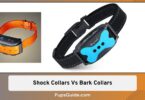We all love our huskies, those majestic creatures with striking blue eyes and a spirit as wild as the tundra.
However, sometimes the challenge of training a husky, let’s say for biting, can feel like navigating through a winter storm.
Shock collars are often considered an effective tool in the training arsenal, but what if you find yourself wondering why shock collar not working on Husky? In this guide, we’ll explore common issues and offer solutions to ensure your shock collar becomes the training ally you hoped for.
4 Troubleshoots to Run When the Collar Doesn’t Work on Your Husky
Here’s why the shock collar may not be working and how to solve the problem.
Have You Bought the Right Collar? Huskies Demand Toughness!
Huskies are known for their resilience and tenacity, so it’s essential to ensure that your shock collar matches their robust nature. Sometimes, the shock collars designed for smaller breeds simply won’t cut it for these Arctic athletes.
Check the specifications of your collar or, better yet, do some research. Look for collars explicitly designed for huskies, with shock levels calibrated to capture their attention. Remember, huskies have a knack for brushing off low-intensity shocks, so it might be time to upgrade to a more powerful collar.
Are the Prongs Reaching the Husky’s Skin? Size Matters!
One common mistake is underestimating the fur thickness of a husky’s double coat and how tight the collar is on the dog. The shock collars work when the prongs make contact with the skin, otherwise, they don’t.
Therefore, opt for prongs that are at least 3/4 inches long, ensuring they penetrate the dense fur and reach the husky’s skin.
Winged prongs, designed to navigate through the coat and make direct contact with the skin, can also be a game-changer. It’s like making sure your arrow hits the bullseye rather than getting lost in the target’s periphery.
Is the Collar Faulty? A Blinking Light Can Speak Volumes!
Modern shock collars often come equipped with indicator lights, and they’re not just for decoration. If you notice a blinking light or any irregularities in the collar’s design, it could be a sign of a malfunction.
To rule out this possibility, try the collar on yourself—yes, you read that right. Give it a test run to ensure it’s delivering the right amount of shock. See whether it fails on you, in which case, it’s time to contact customer support for a replacement. Don’t let a faulty collar be the reason your husky remains untrained.
Was the Collar Working Before? Water Woes Could Be the Culprit!
Huskies have a natural affinity for water, whether it’s a puddle, a pond, or a full-blown bath. Your shock collar may have lost its edge due to water damage. Check the collar’s specifications to see whether it’s waterproof or not.
If not, your husky’s aquatic adventures could be the culprit behind a malfunctioning collar. To prevent this issue in the future, invest in a waterproof shock collar or be vigilant about removing it before your husky takes a dip.
Tips to Ensure Collars Work in the Future: Lessons Learned
Now that we’ve troubleshooted the present, let’s focus on the future. How can you ensure your shock collar remains a reliable training tool for your husky? Here are some practical tips:
a. Regular Maintenance is Key:
Just like any other piece of equipment, shock collars need regular checks and maintenance. Inspect the collar for any signs of wear, tear, or malfunction. Ensure that the prongs are clean and free from debris, and the collar is securely fastened around your husky’s neck.
b. Invest in a Waterproof Collar:
Given your husky’s penchant for water, investing in a waterproof shock collar is a wise choice. This ensures that even the most enthusiastic water-loving husky won’t render the collar ineffective.
c. Keep Shock Levels Consistent:
Consistency is key in dog training for boundaries or otherwise. If you’re using a shock collar, make sure the shock levels are consistent. Sudden changes in intensity can confuse your husky and diminish the collar’s effectiveness.
d. Mix Shock Collar Training with Positive Reinforcement:
While shock collars can be effective, they should be part of a broader training approach. Combine their use with positive reinforcement techniques to create a well-rounded training experience for your husky. This could include treats, praise, or play as rewards for desired behaviors.
e. Understand Your Husky’s Limits:
Every husky is unique, and understanding your dog’s tolerance levels is crucial. Some huskies may respond well to low-intensity shocks, while others require a stronger stimulus. Pay attention to your husky’s reactions and adjust the collar settings accordingly.
f. Consult a Professional Trainer:
It’s better to consider seeking the assistance of a professional dog trainer when nothing works. They can provide personalized guidance and ensure you’re using the shock collar in a humane and effective manner.
Shock Collar Not Working on Husky? – Conclusion
Training a husky can be a challenging yet rewarding journey. Don’t throw in the towel just yet when the collar doesn’t work.
By ensuring you have the right collar, checking prong length, troubleshooting faults, and following future-proofing tips, you can turn your shock collar into a valuable tool in your husky training toolbox.
Remember, it’s not just about shocking your husky into obedience—it’s about building a trusting and respectful relationship through effective communication.








Leave a Comment